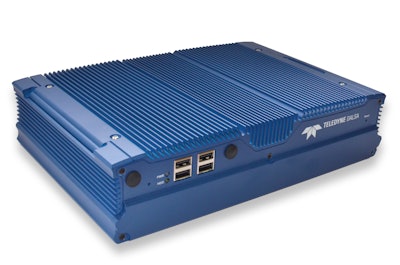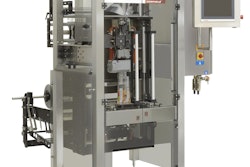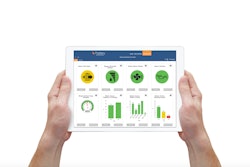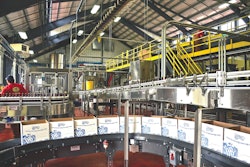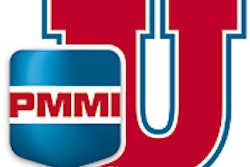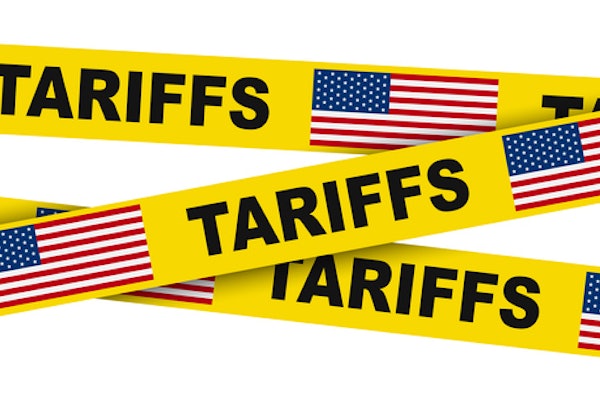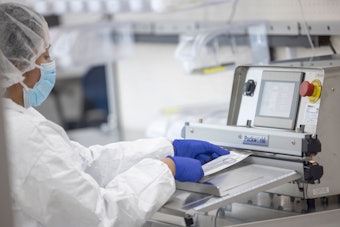While relatively new to the industry, Packaging Efficiency Solutions (P.E.S.) has hit its stride in building equipment for the pharmaceutical and nutraceutical industries. The Morristown, N.J.-based OEM was founded as a three-person team in 2012, and has since grown to a team of 10, expanding its north east roots to reach end user customers across the country.
Aside from manufacturing its own line of labelers, fillers, and electronic counters, P.E.S. also integrates and refurbishes control and vision inspection systems on older pharmaceutical slat filling equipment.
During a recent slat filler project, Andrew Smith, P.E.S. general manager, was tasked with adding a new vision inspection system to an old slat filler and harmonizing the communication and signaling between the two. Smith also wanted to be able to configure inputs, outputs, and communication protocols to eliminate the need to alter the machine controls.
So Smith recruited Teledyne DALSA, one of the OEM’s current suppliers, to equip the STF-200 pharmaceutical slat filler with a new inspection system.
“We can connect Teledyne cameras right into the GEVA 3000 CPU controls platform that we use for the machine to eliminate the need for a separate controller,” Smith says. “There is a completely seamless integration between our machine and the camera, and because of that, we were looking for a way to build a slat inspection system that would utilize a lot of the same capabilities of our bottle label inspection equipment.”
Teledyne DALSA’s Genie nano cameras take a picture of each slat or change part as it passes through the machine. The cameras verify the presence and the color of the product, and then a PC analyzes the images to verify the tablets are the proper size and shape. Smith also implemented Teledyne DALSA’s Sherlock vision software to allow P.E.S. to create their own HMI interface.
“We have a lot of flexibility in how we make the system look, and you don’t get that with a company that just makes vision systems,” Smith says. “You basically buy their product and you have to find a way to make it work with your machine. Whereas with Teledyne DALSA, we tailor it however we want and we customize the interface and the controls.”
Emerging technology
While the technology in pharma slat fillers has been around for more than 70 years, Smith says the STF-200 integrated controls and single HMI make it stand out.
“There is no separation between the machine and vision control like you would see on other units,” Smith says. “We wanted a system that wasn’t just an add on to the filler itself, but would actually work in conjunction and be part of the system as a opposed to something you just bolted on and worked around. And the technology we used from Teledyne made it possible to unify communication between the devices.”
Remote capabilities
In working with Teledyne DALSA, Smith was also able to bring remote monitoring capabilities into play with the STF-200.
“We were able to integrate the machine control system, and we can talk to other network components on the line,” Smith says. “It allows us easy access to the outside world from the machine. It’s not something we can get with other suppliers’ equipment, but we can do it easily with Teledyne’s system. We can transfer data from our machine, the cameras, or other machines and servers on the network. It allows our operators to see the status, health, OEE, and look at the machine from remote locations.”
Automation reduces human error
While adoption may be slow for the STF-200, Smith says customers enjoy using one HMI to monitor the entire machine.
“Most of our customers are open, but some of them are a reluctant to the new idea of having all of those functions integrated into one interface,” Smith says. “It takes a little while to get into the market, but it’s coming along.”
But one end user approached P.E.S. specifically because of the OEM’s fully integrated machine and enhanced vision system.
“We have customers running controlled substances that needed a way to inspect slats without using operators,” Smith says. “They were concerned with human error on the inspection process, and because of that, they looked at our cameras as a way to do a full inspection on the product prior to it getting into the bottle successfully.”
Teledyne DALSA’s vision products have also helped the OEM tackle serialization compliance with its new labeling systems.
“We are improving and designing new labelers to make our systems serialization ready,” Smith says. “We are looking at ways to integrate the camera systems into a new electronic counter design to make our equipment a viable option for pharma end users."
